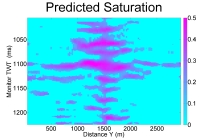MonCO2 - Monitoring Geological CO2 storage
MonCO2 - Monitoring Geological CO2 storage
The full project name is Monitoring Geological CO2 Storage: Quantitative CO2 Prediction with Uncertainty from Physical Modeling and Multiple Time-Lapse Data Types. The project is funded by the Norwegian Research Council and the industrial partners Statoil and ExxonMobil. We collaborate with the University of Bergen and Stanford University to develop improved methods for quantitative prediction of the distributions of CO2 in subsurface storage sites. Statistical models are used as the key tool for integrating repeated measurements of multiple data types within physical models describing the CO2 saturation changes.
Main goal
Improved quantitative prediction of the spatial distributions of CO2 in subsurface storage.
Contribution to CO2-handling:
- A rock physics library provides the basis for a systematic approach to CO2 monitoring
- Joint inversion of multiple data sources constrained by rock physics models assures consistent use of data
- Quantitative interpretation of inversion provides the spatial distribution of CO2 in subsurface storage
- Reliable prediction of CO2 ensures public safety and support for continued CO2 storage
- Quantitative assessment of CO2 saturation provides the limits for storage rates and capacity essential for the economy of a storage site in emission trading
Large amounts of data
An essential part of the project is the integration of data from the Sleipner capture and storage gas processing facility. This facility is the world's first fully operational offshore gas field with CO2 injection. The storage is in a geological layer 1,000 meters below the sea floor. Multiple seismic and gravimetric monitoring surveys have been performed in the area starting prior to the first injection in 1996.
These repeated geophysical measurements are used to monitor the CO2 plume, as they are indirect observations of the CO2 saturation changes. There are several challenges in the interpretation of the geophysical measurements in terms of changes in CO2 saturation. Firstly, the data amount is massive and thus there is a need for efficient algorithms to process the data. Secondly, there is uncertainty both in measured data, and related to how the rock properties will change when the original brine filling is substituted with CO2. These uncertainties must be accounted for by the methodology.

Project period
Financing
- Research Council of Norway
- ExxonMobil
- Statoil
Partners
- University of Bergen
-
Stanford University/
Petrophysical Consulting, Inc.



 How to get to NR
How to get to NR Share on social media
Share on social media Privacy policy
Privacy policy